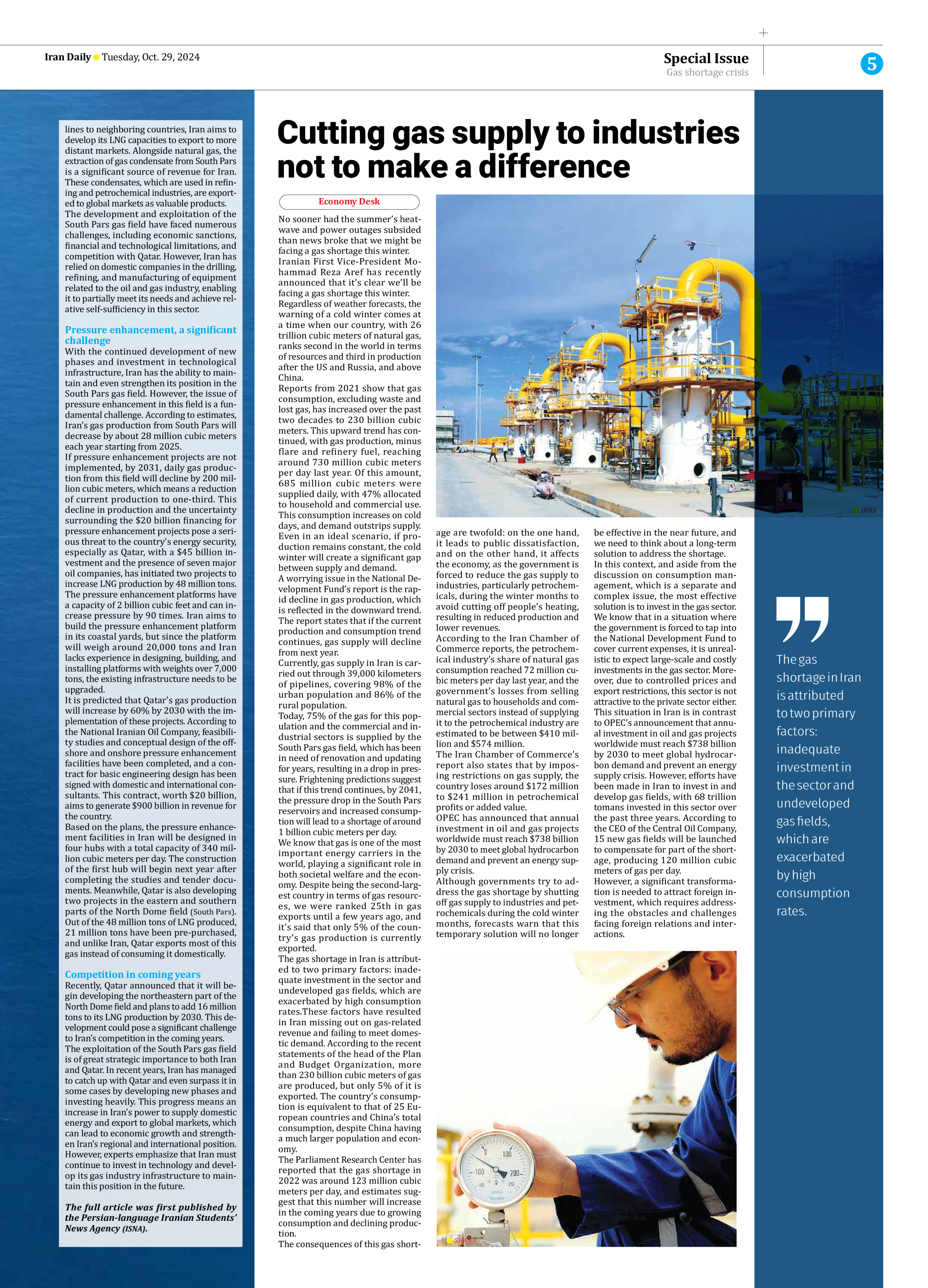
Cutting gas supply to industries not to make a difference
No sooner had the summer’s heatwave and power outages subsided than news broke that we might be facing a gas shortage this winter.
Iranian First Vice-President Mohammad Reza Aref has recently announced that it’s clear we’ll be facing a gas shortage this winter.
Regardless of weather forecasts, the warning of a cold winter comes at a time when our country, with 26 trillion cubic meters of natural gas, ranks second in the world in terms of resources and third in production after the US and Russia, and above China.
Reports from 2021 show that gas consumption, excluding waste and lost gas, has increased over the past two decades to 230 billion cubic meters. This upward trend has continued, with gas production, minus flare and refinery fuel, reaching around 730 million cubic meters per day last year. Of this amount, 685 million cubic meters were supplied daily, with 47% allocated to household and commercial use. This consumption increases on cold days, and demand outstrips supply. Even in an ideal scenario, if production remains constant, the cold winter will create a significant gap between supply and demand.
A worrying issue in the National Development Fund’s report is the rapid decline in gas production, which is reflected in the downward trend. The report states that if the current production and consumption trend continues, gas supply will decline from next year.
Currently, gas supply in Iran is carried out through 39,000 kilometers of pipelines, covering 98% of the urban population and 86% of the rural population.
Today, 75% of the gas for this population and the commercial and industrial sectors is supplied by the South Pars gas field, which has been in need of renovation and updating for years, resulting in a drop in pressure. Frightening predictions suggest that if this trend continues, by 2041, the pressure drop in the South Pars reservoirs and increased consumption will lead to a shortage of around 1 billion cubic meters per day.
We know that gas is one of the most important energy carriers in the world, playing a significant role in both societal welfare and the economy. Despite being the second-largest country in terms of gas resources, we were ranked 25th in gas exports until a few years ago, and it’s said that only 5% of the country’s gas production is currently exported.
The gas shortage in Iran is attributed to two primary factors: inadequate investment in the sector and undeveloped gas fields, which are exacerbated by high consumption rates.These factors have resulted in Iran missing out on gas-related revenue and failing to meet domestic demand. According to the recent statements of the head of the Plan and Budget Organization, more than 230 billion cubic meters of gas are produced, but only 5% of it is exported. The country’s consumption is equivalent to that of 25 European countries and China’s total consumption, despite China having a much larger population and economy.
The Parliament Research Center has reported that the gas shortage in 2022 was around 123 million cubic meters per day, and estimates suggest that this number will increase in the coming years due to growing consumption and declining production.
The consequences of this gas shortage are twofold: on the one hand, it leads to public dissatisfaction, and on the other hand, it affects the economy, as the government is forced to reduce the gas supply to industries, particularly petrochemicals, during the winter months to avoid cutting off people’s heating, resulting in reduced production and lower revenues.
According to the Iran Chamber of Commerce reports, the petrochemical industry’s share of natural gas consumption reached 72 million cubic meters per day last year, and the government’s losses from selling natural gas to households and commercial sectors instead of supplying it to the petrochemical industry are estimated to be between $410 million and $574 million.
The Iran Chamber of Commerce’s report also states that by imposing restrictions on gas supply, the country loses around $172 million to $241 million in petrochemical profits or added value.
OPEC has announced that annual investment in oil and gas projects worldwide must reach $738 billion by 2030 to meet global hydrocarbon demand and prevent an energy supply crisis.
Although governments try to address the gas shortage by shutting off gas supply to industries and petrochemicals during the cold winter months, forecasts warn that this temporary solution will no longer be effective in the near future, and we need to think about a long-term solution to address the shortage.
In this context, and aside from the discussion on consumption management, which is a separate and complex issue, the most effective solution is to invest in the gas sector. We know that in a situation where the government is forced to tap into the National Development Fund to cover current expenses, it is unrealistic to expect large-scale and costly investments in the gas sector. Moreover, due to controlled prices and export restrictions, this sector is not attractive to the private sector either.
This situation in Iran is in contrast to OPEC’s announcement that annual investment in oil and gas projects worldwide must reach $738 billion by 2030 to meet global hydrocarbon demand and prevent an energy supply crisis. However, efforts have been made in Iran to invest in and develop gas fields, with 68 trillion tomans invested in this sector over the past three years. According to the CEO of the Central Oil Company, 15 new gas fields will be launched to compensate for part of the shortage, producing 120 million cubic meters of gas per day.
However, a significant transformation is needed to attract foreign investment, which requires addressing the obstacles and challenges facing foreign relations and interactions.







